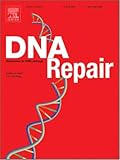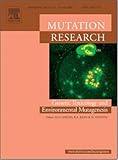|
|
Help |
| Home - Health Conditions - Fanconi Anemia (Books) | |
e99 Online Shopping Mall
|
|
Help |
| Home - Health Conditions - Fanconi Anemia (Books) | |
| Back | 21-28 of 28 |
click price to see details click image to enlarge click link to go to the store
| 21. C. elegans FANCD2 responds to replication stress and functions in interstrand cross-link repair [An article from: DNA Repair] by S.J. Collis, L.J. Barber, J.D. Ward, J.S. Martin | |
 | Digital:
Pages
(2006-11-08)
list price: US$10.95 -- used & new: US$10.95 (price subject to change: see help) Asin: B000PAUXIO Canada | United Kingdom | Germany | France | Japan |
|
Editorial Review Product Description | |
| 22. Interstrand crosslink-induced radials form between non-homologous chromosomes, but are absent in sex chromosomes [An article from: DNA Repair] by A.E. Newell, Y.M.N. Akkari, Y. Torimaru, Rosenthal | |
 | Digital:
Pages
(2004-05-04)
list price: US$8.95 -- used & new: US$8.95 (price subject to change: see help) Asin: B000RQZLWY Canada | United Kingdom | Germany | France | Japan |
|
Editorial Review Product Description | |
| 23. Influence of double-strand-break repair pathways on radiosensitivity throughout the cell cycle in CHO cells [An article from: DNA Repair] by J.M. Hinz, N.A. Yamada, E.P. Salazar, R.S. Tebbs | |
 | Digital:
Pages
list price: US$8.95 -- used & new: US$8.95 (price subject to change: see help) Asin: B000RR6K8W Canada | United Kingdom | Germany | France | Japan |
|
Editorial Review Product Description | |
| 24. Drosophila homologs of FANCD2 and FANCL function in DNA repair [An article from: DNA Repair] by L.R. Marek, A.E. Bale | |
 | Digital:
Pages
(2006-11-08)
list price: US$10.95 -- used & new: US$10.95 (price subject to change: see help) Asin: B000PAUXGG Canada | United Kingdom | Germany | France | Japan |
|
Editorial Review Product Description | |
| 25. Role of the Fancg gene in protecting cells from particulate chromate-induced chromosome instability [An article from: Mut.Res.-Genetic Toxicology and Environmental Mutagenesis] by L.C. Savery, E. Grlickova-Duzevik, S.S. Wise, Thom | |
 | Digital: 7
Pages
(2007-01-10)
list price: US$10.95 -- used & new: US$10.95 (price subject to change: see help) Asin: B000PC6NI6 Canada | United Kingdom | Germany | France | Japan |
|
Editorial Review Product Description | |
| 26. FANCD2 monoubiquitination and activation by hexavalent chromium [Cr(VI)] exposure: Activation is not required for repair of Cr(VI)-induced DSBs [An article ... Toxicology and Environmental Mutagenesis] by S.K. Vilcheck, S. Ceryak, T.J. O'Brien, Patierno | |
 | Digital:
Pages
(2006-11-07)
list price: US$10.95 -- used & new: US$10.95 (price subject to change: see help) Asin: B000PAUP32 Canada | United Kingdom | Germany | France | Japan |
|
Editorial Review Product Description | |
| 27. Two in a Million: A True Story about Illness and Love by Ben Murnane | |
| Hardcover: 198
Pages
(2008-01)
Isbn: 1906353034 Canada | United Kingdom | Germany | France | Japan | |
| 28. Saving Henry: A Mother's Journey by Laurie Strongin | |
 | Hardcover: 288
Pages
(2010-03-02)
list price: US$22.99 -- used & new: US$8.79 (price subject to change: see help) Asin: B003XU7VYW Average Customer Review: Canada | United Kingdom | Germany | France | Japan |
|
Editorial Review Product Description Saving Henry is the eye-opening and inspiring story of how far a family will go to save the life of their child. Laurie Strongin's son Henry was born with a heart condition that was operable, but which proved to be a precursor for a rare, almost-always fatal illness: Fanconi anemia. Deciding to pursue every avenue that might provide a cure, Laurie and her husband signed on for a brand new procedure that combined in vitro fertilization with genetic testing to produce a baby without the disease, who could be a stem cell donor for Henry. As Laurie puts it: "I believe in love and science, nothing more and nothing less." Laurie and her husband endured nine failed courses of the procedure before giving up. But Saving Henry is also about hope. It is the story of Henry, the feisty little boy who loved Batman, Cal Ripken Jr., and root beer-flavored anesthesia, and who captivated everyone with his spunk and positive attitude. When the nurses came to take blood samples, Henry brandished his toy sword and said, "Bring it on!" When he lost his hair after a chemo treatment, he declared, "Hey, I look like Michael Jordan!" Laurie became a fervent advocate for stem cell research, working with policymakers and the scientific community to bring attention to Henry's case and to the groundbreaking research that could save many lives. Henry's courage and bravery inspired nurses, doctors, friends, and family. Saving Henry is the story of one family's search for a cure, and the long-lasting scientific impact their amazing little boy has had. Praise for Saving Henry "How do you make beauty and meaning out of unimaginable sorrow? Saving Henry is a stirring account of struggle, love, and loss that manages to be both honest and inspiring." "Henry's story is important and newsworthy; a testament to how the debate over medical technology and stem cell research is not just an academic argument, but also a searingly personal one. Mostly, though, it's an intimate love story. We should all learn from Henry what his family has learned--to live well and laugh hard." "Saving Henry is a marvelously told tale of love triumphant. Parents often say they would do anything for their children. This is the story of a couple that actually did." "There's a reason Saving Henry rings with so much truth: the author lived every word of it. It's a vivid, beautifully rendered, and almost painfully honest account of a journey none of them wanted to take, but could not avoid, thanks to a bad throw of the genetic dice. Laurie, her husband Allen, and especially little Henry, become pioneers in a landscape of complex technological procedures that offer hope but also bring pain . . . and yet they keep trying. This is a tale of a family that will not quit." "Strongin has a gift for telling a complex medical story as an unfolding family narrative--a family that in so many ways is my family, your family, anybody's family. Any of us in today's world could find ourselves facing the difficult and challenging set of decisions this family had to make. Strongin's story is a truthful and honest road map we may want to follow." Customer Reviews (15)
| |
| Back | 21-28 of 28 |